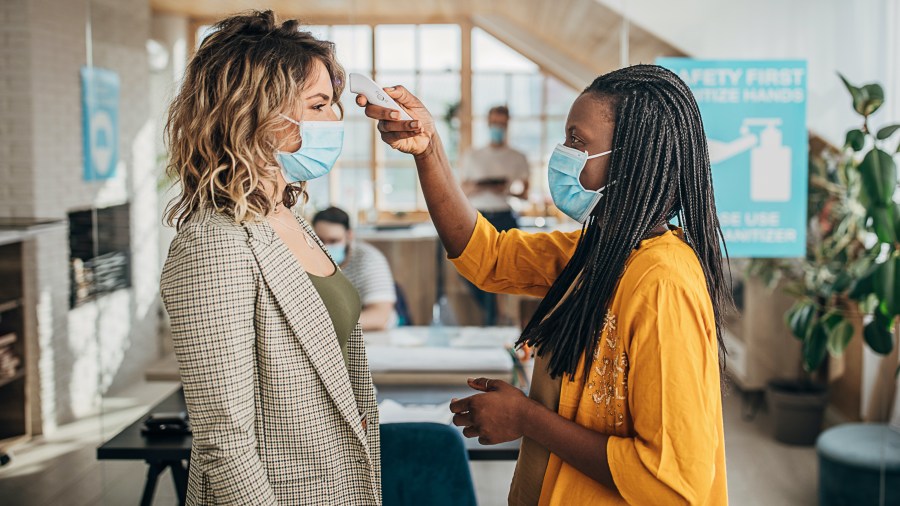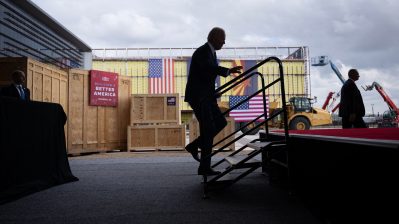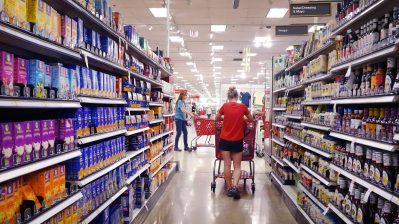Is our economy ready for long COVID?

At the start of the pandemic, there was an overwhelming sense that once there were vaccines, you’d be less likely to die from COVID-19 and the risk would all but go away. Then came long COVID.
According to one estimate, between 7 million and 23 million people in the United States have developed long COVID. That means that weeks or even months after an initial infection, they’re still suffering from a wide range of debilitating symptoms including shortness of breath, brain fog and heart palpitations.
And, in some cases, symptoms are so severe, people have left their jobs. So is our economy prepared?
“If you think about the way that our country manages disability, probably no,” said Jessica Malaty Rivera, an epidemiologist and senior adviser at the Rockefeller Foundation’s Pandemic Prevention Institute. “We can barely get our disability to work for people who are pregnant and having children. So I can’t imagine that it’s going to be very accommodating to those who are experiencing long COVID.”
On the show today, we’ll talk with Malaty Rivera about the health and socioeconomic effects of long COVID.
In the Newsfix, we’ve got a quick and dirty explainer on the bond yield curve and why it’s all over the news today. Plus, we’ll hear from listeners about the Farmers’ Almanac’s weather predictions and the Oscars, and a veterinarian shares a surprising answer to the Make Me Smart question.
Here’s everything we talked about today:
- “Is ‘long Covid’ worsening the labor shortage?” from the Brookings Institution
- “Evidence grows that vaccines lower the risk of getting long COVID” from NPR
- “NIH’s sluggish efforts to study long Covid draw patient, researcher ire” from STAT
- “U.S. Stock Indexes Rise, Oil Prices Extend Decline” from The Wall Street Journal
- “Covid-19 Coverage for the Uninsured Is Ending” from The Nation
- ICYMI: “Make Me Smart’s” Cherry Blossom party
Make Me Smart March 29, 2022 transcript
Note: Marketplace podcasts are meant to be heard, with emphasis, tone and audio elements a transcript can’t capture. Transcripts are generated using a combination of automated software and human transcribers, and may contain errors. Please check the corresponding audio before quoting it.
Kimberly Adams: I’m Kimberly Adams. Welcome everyone to Make Me Smart, where none of us is as smart as all of us. Thank you for hanging out.
Kai Ryssdal: That’s That’s right. I’m Kai Ryssdal, it’s Tuesday, we’re gonna do an in depth conversation, shall we say about a single topic. Today is long COVID and why long COVID? Number one, because something like somewhere between seven and 23 million people have it. So there’s that. Number two, I heard about a thing called medium COVID. The other day, which just I’m not in the mood for either. So we’re going to talk about that. And it’s just this is this is the life that millions of people in this economy are living and so we’re going to talk about it.
Kimberly Adams: Yeah, and if you think about that, between seven and 23 million, the fact that we don’t know. And that huge range tells us that we really don’t know a lot about it and some COVID long haulers are saying that they’re feeling fatigue, brain fog, shortness of breath, lots of other problems. And in some cases, people have actually had to leave their jobs leave the workforce. There is a lot of research ongoing right now looking into long COVID. You have the National Institutes of Health, which launched a $1 billion initiative to look at this, and several other private institutions are researching it as well. Here to make a smart on what we do and do not know about long COVID is Jessica Malaty Rivera, she’s an epidemiologist and senior adviser to the Rockefeller Foundation’s Pandemic Prevention Institute. Hey, Jessica.
Jessica Malaty Rivera: Hey, thanks for having me.
Kimberly Adams: So first of all, what exactly is long COVID. Do we even have a standard definition for it yet?
Jessica Malaty Rivera: You know, the standard definition, as far as you know, how people are diagnosing long COVID is that it’s, you know, the acronym is now post-acute sequelae. So it’s basically a combination of either symptoms that were existing while infected or have occurred after recovery that persist for an indefinite period of time. And it is not as standard as you would hope because there aren’t really two cases that look exactly the same. So it’s, it’s a big kind of gray cloud.
Kai Ryssdal: So is it is it luck of the draw, whether you – the COVID, you assuming you’re vaccinated, right? Whether the luck of the draw whether the COVID you get is a bad cold or is this thing that can turn your life upside down?
Jessica Malaty Rivera: You know, there are some clues as to who might have a proclivity to lung COVID. But I know plenty of cases personally, and just from the data of people with no pre-existing conditions, no, you know, concerns with their immune systems that have had COVID a long COVID or PASC, vaccinated and not so it’s it, unfortunately, is one of those gambles, which is why the messaging has been so strong that vaccines are our best option to reduce risk, not eliminate it. But that it is a risk factor for anybody who gets infected.
Kimberly Adams: Yeah, this is something that’s really stuck out to me, it’s, and I said this when we were coming up with this idea, it’s like, I feel like once there were vaccines, and people were convinced that you were less likely to die of COVID, that the risk went away, but long COVID can really mess you up.
Jessica Malaty Rivera: It really can. And I think that you said something very critical there in the sense that risk is about layers and layers of ways to reduce that risk when it comes to all the non-pharmaceutical interventions and pharmaceutical interventions that we have for COVID. But eliminating risk is virtually impossible. I mean, the only way you could eliminate risk is to not get COVID, which is a very difficult thing to do two plus years into a pandemic.
Kai Ryssdal: Well, speaking of two plus years, how come there’s still so many unknowns? Is it just because this virus is so adaptable and just smart I guess?
Jessica Malaty Rivera: Yes. I mean, it is a novel virus. We have not seen SARS COV-2 in the human population before its emergence in late 2019. And as a result, we’re still learning as we go. It’ s kind of like, you know, taking a test as it’s being written. And we will be studying this for a very, very long time because of all of the unknowns and I think that the unknowns are not that surprising, it is something that we are hoping we get more clarity on, which is why the funding is such a critical part of the next phase of the pandemic to make sure that we have enough studies going on enough people participating and enough momentum to make sure that we really, really help people, because it’s not going to be over when the pandemic is over in the sense that people will still be dealing with COVID-19 for many, many years after that.
Kimberly Adams: Well, that follows to the next question that I was gonna ask, you’re just setting us up perfectly. Aside from the effects that people are going to have on their health, from long COVID and well being and mental health, what do you think are going to be some of the broader social and economic effects of long COVID, as this does stay with us for a while?
Jessica Malaty Rivera: It’s an overwhelming question to think about, to be honest, I mean, if the estimates are anywhere near accurate, if you’re thinking about somewhere between 10 to 30%, of people who get COVID experiencing some form of lingering COVID, that’s a lot of people, we’ve got 330 million people in the United States alone. And you’re dealing with people who could be experiencing long term brain fog and long term disability and issues that cause them to like you mentioned earlier, you know, staying away from their jobs having to get additional help. I am concerned about what this looks like for our healthcare system, our healthcare system has been, you know, very strained continuously for a number of years. If you think about all of the deferred, medical things that have had to happen because of our hospitals being overwhelmed, because doctors are being overworked because of the people in health care, leaving health care because of how burned out they are. That’s also kind of another one of those consequences. I’m worried about what this will mean for insurance coverage, if this will be considered one of those kind of, you know, dreaded pre-existing conditions. I mean, it has the potential of having very, very long lasting consequences for individual care for our economy, and just the continuity of work.
Kai Ryssdal: What’s the – speaking of individual care –what’s the treatment? Or is it just sit at home? And I mean, I don’t even know.
Jessica Malaty Rivera: Yeah, I mean, again, it’s because there’s no two cases that are exactly the same, it really depends. So if somebody is dealing with, you know, prolonged cardiovascular issues, they’re probably working with a cardiologist to track their heart rate to make sure that their myocarditis or pericarditis is being managed properly. You know, if people are experiencing things like parosmia, which is the prolonged loss of smell, or taste, there’s olfactory training that you can do with an ENT, kind of training your body to wake up your senses, your nerves and your nose, that send those signals to your brain. If it’s brain fog, it could be working with a neurologist, like it’s so many requires so many specialties to be all hands on deck. And it really depends, but I know some folks who feel kind of just tossed in the waves when it comes to trying to care because those specialties are still learning as they go to.
Kimberly Adams: Yeah, I was gonna ask how do you know when your symptom is long COVID versus something else?
Jessica Malaty Rivera: That’s a great question. I mean, I think that’s kind of the part of the anxiety that COVID induces, because I think anybody who’s had COVID wonders, “Wait a second, is this long COVID? Is this allergies is this because I haven’t slept well, this week.” I think that is going to be something that will be difficult for some folks to discern. But I think those who suffer from long COVID really know they’re suffering from long COVID, because life has not returned to normal for them when it comes to their overall baseline health. But that’s kind of like why these studies are really important to kind of track how long did you have a loss of smell and taste? Or how long did you experience fatigue? And there are figuring out ways in which there are benchmarks to say, “Okay, this kind of meets the medium COVID to long COVID spectrum or long COVID to really long COVID spectrum.”
Kai Ryssdal: Do you do suppose that, that the proportion of people with long COVID will go up? Are we – have we seen the worst of that now? Or is there no way to know?
Jessica Malaty Rivera: It’s hard to know right now, I think that one of the concerns that we’ve had throughout the pandemic is that we’ve just never tested enough. And so I think that there’s probably a large proportion of folks who are undiagnosed, who probably are experiencing long COVID from mild to medium infections that they went, you know, undetected, either early in the pandemic or kind of in the middle of the pandemic and just never were tested. And I think that this that’s why the range is so big. I mean, seven to 23 million is in enormous range. And I think it’s trying to account for the fact that given the incidence of COVID in this country, there are millions of people who probably had it and never knew about it.
Kimberly Adams: Are our workplaces ready for long COVID? And this many people having it?
Jessica Malaty Rivera: That’s a great question. I mean, if you think about the way that our country manages disability, probably no, I mean, we can barely get our disability to work for people who are pregnant and having children. So I can’t imagine that it’s going to be very accommodating to those who are experiencing long COVID. You know, I think that job security is a very real thing. And we’re talking about people who do have coverage that could maybe get access to disability benefits, but a lot of those people who got COVID, especially if you’re talking about marginalized, low income communities don’t have that kind of coverage. And so you’re talking about hourly wage workers, people who are undocumented, people who are uninsured, which is millions of people who probably will lose their jobs and their incomes because of long COVID.
Kai Ryssdal: So you listed off a whole long parade of horribles there a little while ago that you’re worried about. Pick one, what’s the biggest thing about long COVID that people ought to, you know, take away and be worried about?
Jessica Malaty Rivera: I worry about our ability to do adequate research to provide answers to something that has just infinite it’s infinite questions. You know, when we see these big, billion and trillion dollar tags, and these headlines of the administration requesting this funding for FDA, this request this funding for NIH, this funding for CDC, all in the kind of umbrella of pandemic response and pandemic preparedness, and then also knowing that we’re running out of funding next week, when it comes to providing testing and monoclonal antibodies and antivirals for people who are uninsured, it’s hard for me to feel hopeful that those dollar amounts are actually going to be realized.
Kai Ryssdal: Well, thank you for an incredibly depressing 11 and a half minutes of your day. We really appreciate it. Jessica – I know look, it’s it’s real, right? And that’s why we want to do this. It was trembling and the idea because it’s this thing that’s happening that that, look, the news is a firehose these days as it has been the last five or six years and this is a key part of it. Jessica Malaty Rivera, she’s an epidemiologist, also a senior advisor at the Rockefeller Foundation’s Pandemic Prevention Institute. Thank you so much for your time.
Kimberly Adams: Thank you.
Jessica Malaty Rivera: Thank you for having me.
Kai Ryssdal: Yeah, right.
Kimberly Adams: Hoo boy, well, I feel like I understand it now at least.
Kai Ryssdal: Yeah me too, I mean, she was she was great, right? She was great. Yeah.
Kimberly Adams: Yeah. And this, this thing about the healthcare infrastructure, you know, I remember all of the energy and attention that was put on shoring up our healthcare infrastructure for that first wave of COVID. And are we going to run out of ventilators, we don’t have enough of this, we don’t have enough of that and we threw money at that problem. And eventually, that problem got solved, at least in terms of equipment and resources, not necessarily in terms of staffing, so she said people have burned out. But like, what do we throw at long COVID? And do we have any more political will or public will to throw things at long COVID? And like she said, we don’t have a great track record on…
Kai Ryssdal: I absolutely think we don’t, I’m gonna answer that question in the positive and the positive is negative, we do not have the political or, or public will to do any more about this. I mean, look around, you know.
Kimberly Adams: Well, I will hope that maybe we will do better this time. Meanwhile, let us know what you think about that conversation. If you perhaps have any hope for the future. Have you developed long COVID? How has it affected you? We’d love to hear your stories. Our number is 508-827-6278, also known as 508-UB-SMART. You can also send us a voice memo at makemesmart@marketplace.org And we’ll be right back.
Kimberly Adams: Alright, we are back. And it’s time for the news fix. And I’ll go first because my story is effectively exactly what Jessica just said, which is a piece in the Nation, about COVID-19 coverage for the uninsured ending, and just laying out all of the different ways that that is going to ripple through the economy and in people’s lives. There was a poll in that’s mentioned in the story that a poll from – I want to say April of 2020. That said, one in 10, Americans would avoid care because of costs, even if they believe they had COVID. And now they’re talking about thus far, the industry thus far, $18 billion has been paid out for COVID-related care for the uninsured, including an average of $360 per uninsured person for COVID testing. And now this stuff could potentially come out of pocket. I mean, we’re talking about thousands of dollars in hospital costs, if people get COVID. Testing, I mean, if somebody has to pay out of pocket for a test, they’ve been getting for free the last couple years, are they really going to test?
Kai Ryssdal: They’re not going to test. They’re not gonna test.
Kimberly Adams: Yeah, and then are they going to get treatment and, and when it comes to those anti viral pills and things to actually treat COVID, how many people are going to forego care simply because they don’t want to end up in medical debt. And it’s, it’s a real concern. And, again, we’re looking looking, I’m looking down the street here in Washington, hoping for someone to do something.
Kai Ryssdal: Okay, so total change of topic for my little news item, you’re going to be hearing a lot the next, I don’t know probably a little while actually, about the yield curve. So we’re gonna do a 30 second primer on the yield curve, then we’re gonna do 30 seconds on an inverted yield curve, and then you’ll know what you’re talking about when you read the papers. So the yield curve is the range over which government debt, government treasury bonds, pay interest. And generally speaking, the government has to pay you more interest to borrow your money for longer. So on a 30 year bond, I’m making these numbers up the interest rate, the yield will be 3%. On a three month bond or note, actually, the interest rate will be 1%. Right. So the curve slopes up and to the right, the longer the government has your money, the more it has to pay you. What happens in an inverted yield curve situation is that the shorter term debt has higher yields, that is to say a two year note will be paying two and a half percent, and the 30 year bond will be paying 1%. Okay, those are made up numbers. But that’s the very quick and dirty on a yield curve and an inverted yield curve. What is happening now and in fact, happened for about a nanosecond today on the twos and 10s, the two year notes and the 10 year notes is that they inverted for a like like a heartbeat, right? So which is to say the two year note paid more interest rate than the 10 year note did. And here’s why that matters. Inverted yield curves are often seen as a sign of a recession looming. Now, yield curves can invert without a recession happening. But recessions are almost always preceded by an inverted yield curve. Okay. Why? Because here’s what happens when long term rates go down. That is a sign that investors don’t believe there’s going to be much growth, and they’re going to get paid for their money sooner in the short term market in the near term bonds than they do in the long term market. Now you know what’s happening when a yield curve inverts. Now you know what it’s going to mean when you read it in the newspapers. And I’m done with the bond market for today. Thank you very much for coming to my TED Talk.
Kimberly Adams: That was a great explanation Kai.
Kai Ryssdal: Thank you very much.
Kimberly Adams: Awesome.
Kai Ryssdal: Thank you very much. Let’s move on.
Kimberly Adams: All right. That’s it for the news fix. Let’s do the mailbag.
Kai Ryssdal: I like that sting. That’s a good sting. So if you missed it somehow first of all check out the video I’m sure it’s on our show page but last Friday we did a cherry blossom party to mark the cherry blossom events in Washington D.C. which now are they still there on the trees? I mean, it’s been terrible weather and windy.
Kimberly Adams: It’s been terrible weather but some of them are hanging on, resilient little flowers.
Kai Ryssdal: Fair enough maybe because they’re frozen on anyway. We got this.
Kimberly Adams: Possibly. Yes.
Amanda: Hi. Kimber-Kai, or Kai-berly. Can’t decide what your show name should be now, this is Amanda from Columbus, Ohio. Something that makes me think about the start of spring is the edict that there will be three snows after the forsythia bloom, coming from the Upper Midwest where we feature far more than four seasons, including fall, spring and second winter. This old folk saying actually holds pretty true here. But I recently read on Farmer’s Almanac that this might be an Ohio thing. Have you ever heard of it? Or do you have other predictors that you use for the start of spring?
Kai Ryssdal: Wow. So one of my memories of my childhood is in the backyard of our old house in Briarcliff Manor, New York. We had a bunch of forsythia bushes, and I remember them blooming and being gorgeous yellow, but I have never heard that phrase.
Kimberly Adams: I am from Missouri, I have not heard that phrase. But my good friend in St. Louis was talking to me about her forsythia the other day. And it got very cold there too. So I don’t know, I don’t know if we, if I ever heard any sort of idioms about predicting spring.
Kai Ryssdal: I think we’re coming down on this being an Ohio thing. That’s what I’m saying.
Kimberly Adams: Yeah, I think in Ohio thing. Okay. We also got this next voice memo about the Oscars.
Erica: This is Erica from New York. I was listening to yesterday’s discussion about the Oscar ceremony, and I didn’t watch it. But I’ve been really conflicted about the reporting. And I guess I always assumed that if the host was going to tell a joke about a celebrity that they got a heads up that somehow, you know, kind of unofficially, this had been approved. And I guess this shows that that’s not true, which puts for me a lot of past commentary in a much more negative light. And I just wonder if this was something that they would have expected to have known about, or if I was completely off base.
Kimberly Adams: I have definitely heard and seen reporting, that comedians often give people a heads up about jokes that are coming their way to make sure that they’re going to be good sports about it, but I have no idea if this happened. In this case, I’m obviously it seems not, but or how common it is.
Kai Ryssdal: I’m 100% sure that this was not a bit right that that well, so let me back up for a minute. Hosts of the Oscar ceremony are totally scripted, right? And occasionally they they riff but they’re really scripted and and the audience’s in on the bits. Like if you remember when Amy Schumer, for those of you who watched it, sat down to talk to the guy from the “Power of the Dog”, and booted Kirsten Dunst out of her chair. That was a bit and Kristen was was in on it. Is it Kristin or Kirsten? I don’t know either. Anyway, so she was totally on it. That was a bit the the thing that got all the news was not a bit. And Chris Rock was not a host he has hosted but he came out and riffed and clearly that’s what happened there. Let’s let’s just leave it at that.
Kimberly Adams: Yeah. Bridget says it’s Kirsten.
Kai Ryssdal: Thank you very much. I apologize. I apologize. Okay, so this week’s answer the Make Me Dmart question pandemic edition. What is something you thought you knew about this pandemic, but later found out you were wrong about?
Carrie: This is Carrie from Durham, New York. As a veterinarian, I always assumed that dogs would be happier if their family members were present during their vet visit. But what we found out over the past two years of curbside service is that the vast majority of dogs are actually calmer and better behaved when they come in by themselves. Cats being cats don’t seem to care one way or the other. Their families are more split. We have about half of the people who prefer to visit with their pets and the other half who prefer to wait in their cars. Thanks for making me smart. Love the show.
Kai Ryssdal: That’s totally fascinating because my vet does drop off service and so we we let the dogs go in but my dogs are a little shy and they don’t like going in where strangers are. But it’s interesting to know that they’re usually better behaved in there. Fascinating. Cats being cats.
Kimberly Adams: Not surprised that cats don’t care.
Kai Ryssdal: No surprise, no surprise there. No surprise there. All right. Keep sending us your answers via voice memo to our email and makemesmart@marketplace.org. You can leave us a message 508-827-6278 which is of course 508-UB-SMART. That can be the plain old Make Me Smart question which is what is something you thought you knew but found out you were wrong about or maybe we’ll do pandemic for a little while longer? What is something you thought you knew about this pandemic? But found out you were wrong about there too. So anyway, let us know.
Kimberly Adams: Fascinating about the animals especially with all the extra dogs now. Make Me Smart is directed and produced by Marissa Cabrera. Our team also includes producer Marque Greene and Ellen Rolfes, who writes our newsletter. Our intern is Tiffany Bui.
Kai Ryssdal: Today’s program was engineered by Juan Carlos Torrado. on the other side of the glass over there, Brian Allison’s gonna mix it down later. Ben Tolliday and Daniel Ramirez composed our theme music. The senior producer is Bridget Bodnar. Donna Tam is director of On Demand. Marketplace’s. Vice President and General Manager is Neal Scarbrough. There we go, number two day in the can.
Kimberly Adams: Yeah. I’m gonna be thinking about this long COVID conversation all day.
None of us is as smart as all of us.
No matter how bananapants your day is, “Make Me Smart” is here to help you through it all— 5 days a week.
It’s never just a one-way conversation. Your questions, reactions, and donations are a vital part of the show. And we’re grateful for every single one.


















